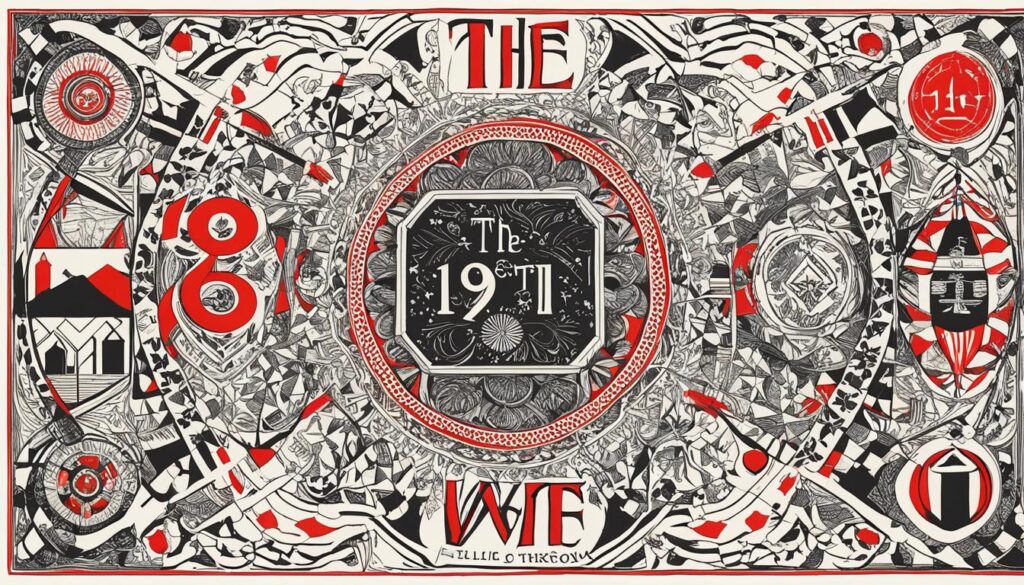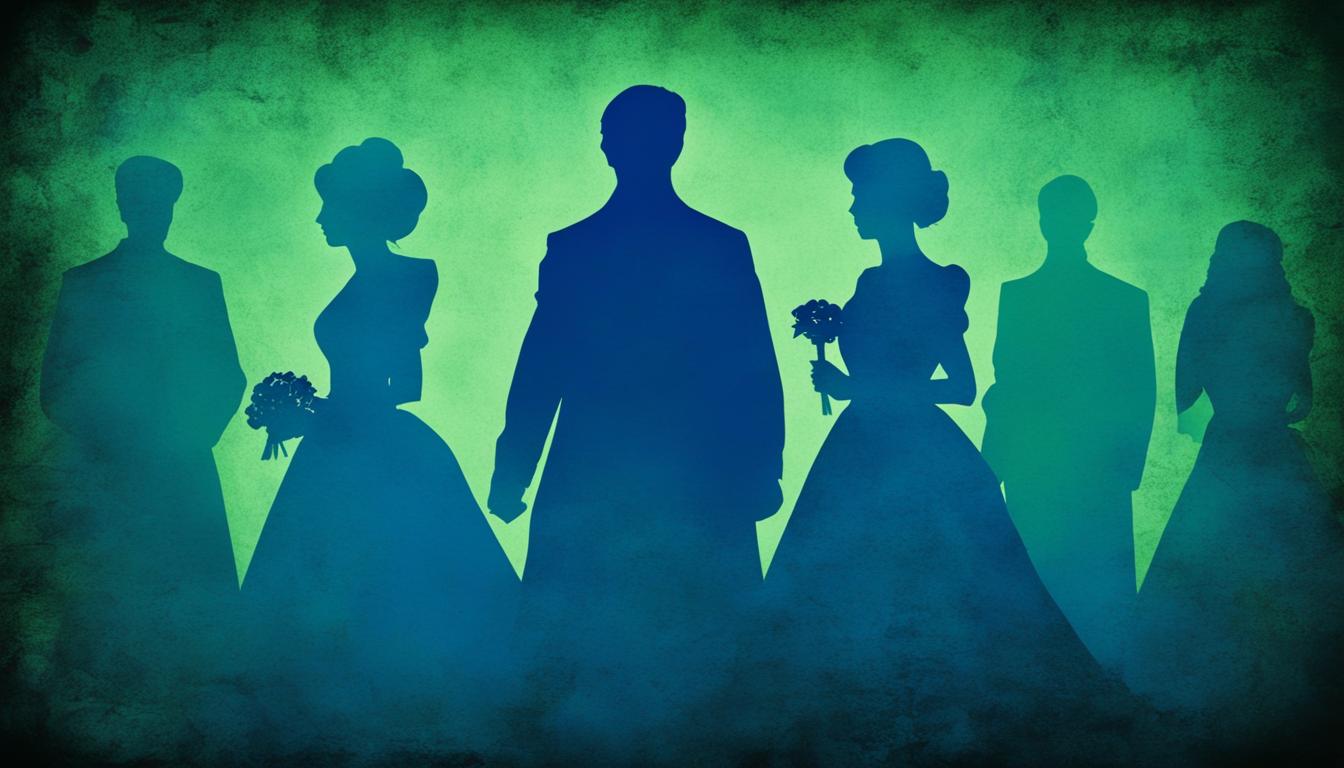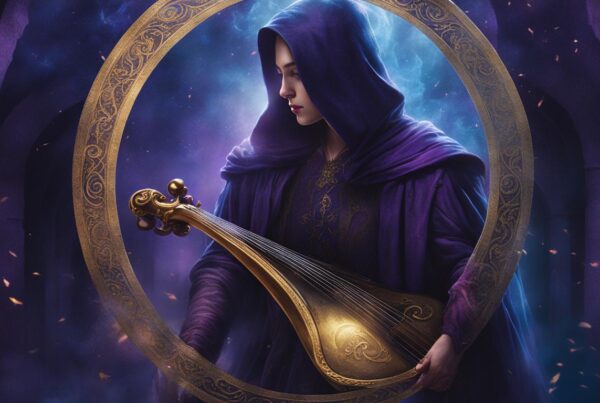The literary world often presents stories that challenge our perspectives and deepen our understanding of complex social dynamics. “The 19th Wife” by David Ebershoff is one such novel that has captivated readers with its intricate exploration of polygamy drama woven into a compelling historical narrative. This detailed audiobook critique assesses the layers beneath this evocative novel, analyzing the depth of Ebershoff’s characters, the dual timelines employed, and the overall quality of the audiobook narration.
Diving into “The 19th Wife” analysis, we shall dissect the elements that make David Ebershoff’s novel a riveting account that transcends time. With particular focus on the audiobook narration quality, this review will deliver insights into the proficiency and emotional precision carried through the voices that bring the tale to life. Delve into this critique to grasp the profound narrative complexities and the auditory elegance that sets this audiobook apart.
Introduction to “The 19th Wife”
Spanning across the controversial edges of polygamy in literature, David Ebershoff’s novel, “The 19th Wife,” explores the complexities of this practice within the context of Latter-day Saints historical fiction. With a foundation deeply rooted in the life of Ann Eliza Young, the narrative unfurls the tapestry of a past littered with the personal cost of polygamy. It is this critical examination of history and its societal implications that intrigue the reader from the outset.
The novel doesn’t merely recount Young’s story; it revives the bygone era of the Latter-day Saints movement and its convolutions through the story arc of a strong female protagonist. Ann Eliza Young’s account, which casts light on the inner workings of polygamous societies, provides more than a mere historical footnote; it presents a nuanced, impactful vista into the era’s social fabric.
Below we outline the structure and content dynamics of “The 19th Wife,” laying out the key elements that have contributed to its acclaim:
- Publication Context: Understanding the era of its release and the motive behind Ebershoff’s dive into a controversial subject matter.
- Ann Eliza Young’s Relevance: How Young’s very existence and memoir provide substance and gravity to Ebershoff’s fictional universe.
- Exploration of Polygamy: The sensitive unraveling of polygamy through a literary lens and its impact on individual identity within the novel.
| Aspect | Details |
|---|---|
| Historical Backdrop | A vivid re-creation of the 19th-century experiences of the Latter-day Saints community, intertwining fact with fiction. |
| Character Journey | Ann Eliza Young’s narrative journey, reflecting the struggle for personal freedom against the backdrop of polygamy. |
| Social Commentary | Ebershoff’s critique of the era’s societal structures and the roles individuals played within them. |
In capturing the myriad hues of polygamist history and the echoes of one woman’s resolve to defy it, “The 19th Wife” offers readers a profound glimpse into a chapter of religious history seldom explored with such gravitas and narrative flair.
Overview of the Dual Narrative Structure
The innovative narrative technique employed in “The 19th Wife” features parallel narratives that create an intricate web connecting the historical and contemporary timeline. This dual narrative not only enriches the tale but also weaves a complex pattern that reveals deeper thematic explorations within the audiobook.
The Historical Tale of Ann Eliza Young
David Ebershoff reaches back into history to recount the life of Ann Eliza Young, the eponymous 19th wife whose real-life crusade against polygamy serves as a cornerstone of the novel. This narrative acts as a springboard, diving into the fragmentation of identity and belief systems that come into play when facing such social and religious challenges.
The Modern-Day Murder Mystery
A counterpoint to the recount of Ann Eliza’s tale is a fictional plot set in the present day, unraveling a murder mystery within a polygamous community. This contemporary storyline mirrors the historical narrative, drawing parallels that bridge time, and suggesting commentary on lasting impacts and evolving perceptions surrounding polygamy.
In exploring these twin stories, Ebershoff leverages a narrative technique that allows readers (or listeners) to oscillate between the past and the present, creating a rich dialogue between the two timelines. The effectiveness of this approach lies in its ability to convey messages that, although rooted in a historical context, resonate powerfully with contemporary issues and sensibilities.
Ultimately, the dual narratives function symbiotically to layer the novel’s meaning and impact, affirming Ebershoff’s skillful narrative strategy and offering audiences a profound auditory experience in the audiobook format.
David Ebershoff’s Interpretation of Polygamy
David Ebershoff’s novel, “The 19th Wife,” dives into the complex and controversial topic of polygamy, offering readers a multifaceted critique of polygamy depiction intertwined with Mormon beliefs. Ebershoff’s exploration casts a revealing light on the internal dynamics and societal implications of polygamous relationships as practiced within historical Mormon contexts.
The author uses his narrative not only to entertain but also to provoke thought, to open a door for listeners to the nuances often hidden behind the public discourse on plural marriages. Through the perspective of both historical events and a modern lens, Ebershoff stimulates a dialogue on the ethical and emotional ramifications of these unconventional family structures.
At the heart of Ebershoff’s portrayal is a sensitive and often critical view on the power hierarchies and gender roles prescribed by Mormon beliefs, as well as the effect of these on individual self-worth and agency. His portrayal does not shy away from analyzing the constrictions and abuses that can arise within polygamous communities, perhaps suggesting a subtle author’s perspective on the inherent imbalance in such relationships.
“Through the lives of his characters, Ebershoff manages to paint a picture that resonates with reality and challenges the listener to rethink preconceived notions about love, faith, and freedom.”
‘The 19th Wife’ not only invites critique but also encapsulates an often overlooked angle on Mormon history — one that extends an empathetic concern for those who lived within its confines. Indeed, the novel’s rich detail and emotional depth serve as a testament to the intricate research and contemplative insight brought by the author’s perspective to this contentious subject.
The Complexity of Characters in “The 19th Wife”
Delving into David Ebershoff’s “The 19th Wife,” we encounter a tapestry woven with intricate character development, depicting personas that span ages, each echoing their own battle for emancipation. These well-crafted characters bridge the gap between 19th-century struggles and modern-day resonances, reflecting an ongoing theme of liberation from historical chains.
Ann Eliza Young’s Struggle for Freedom
An emblematic figure of the emancipation theme, Ann Eliza Young’s character is a testament to resilience and defiance. Historically entrenched yet emotionally timeless, her quest for autonomy is a central pillar of this narrative, allowing readers a glimpse into the soul of a woman who dared to defy the norms of her time. Her story is not simply a reflection of personal growth, but is emblematic of the broader quest for gender equality and social reform.
Contemporary Characters Tackling Old Beliefs
The novel’s present-day characters are similarly ensnared in a web of traditional beliefs and the push for modernity. Their struggles illuminate the cross-century echoes of polygamy’s shadow, crafting a narrative that blends the past with the present, showing the persistence of core human values amidst changing societal norms.
These characters are not static figures but people in constant flux, reacting to the pressures placed upon them by their cultural inheritance and the evolving philosophies of freedom and identity.
| Character | Historical Context | Modern Parallel | Emancipation Arc |
|---|---|---|---|
| Ann Eliza Young | 19th-century polygamy advocate turned critic | Modern counterparts facing legacy of polygamy | Breakaway from oppressive traditions towards self-actualization |
| Contemporary Protagonist | Influenced by historical accounts of Ann Eliza | 21st-century individuals confronting outdated beliefs | Rejection of dogmatic past to forge a new personal identity |
The characters—rooted in real historical episodes and fictional modern scenarios—are not merely personifications of ideas but dynamic individuals whose development provides profound insights into the human condition. As we navigate through their stories of courage and confrontation, we bear witness to the enduring relevance of the emancipation theme.
Audiobook Review: Voice Performance and Delivery
The articulate delivery and profound vocal performance of an audiobook’s narrator can significantly transform the listening experience, with skilled narration having the power to immerse us deeply in the narrative. In our audiobook narration analysis, we scrutinize the intricate balance of tone, pace, and character portrayal that contributes to the acoustic tapestry which brings “The 19th Wife” to life.
Impact of Narration Style on the Story’s Tone
The narration style chosen for an audiobook can either elevate the material or detract from the author’s intent. Through meticulous attention to vocal inflection and cadence, the narrators of “The 19th Wife” achieve a harmonious synergy with the story’s tone. An adept narrator possesses the ability to shift seamlessly between the gravity of somber passages and the levity found in moments of humor or romance—each transition deftly crafted to preserve the emotional essence of the novel.
Diverse Voices: Characterization through Audio
Character portrayal is another facet where vocal performance takes center stage. Audiobook listeners rely on the narrator’s ability to distinguish between characters, lending a unique voice to each that aligns with their personality and background. The dynamic cast of “The 19th Wife” demonstrates their agility in this regard, with each character’s voice carefully modulated to reflect their individual traits and relationships.
| Character | Vocal Qualities | Performance Highlights |
|---|---|---|
| Ann Eliza Young | Steadfast, Firm | Portrayal of resolve and defiance |
| Contemporary Protagonist | Curious, Reflective | Adept transition between introspection and dialogue |
| Historical Figures | Authoritative, Cultured | Authentic representation of the era’s speaking style |
“The emotional spectrum of each character was meticulously captured by the audiobook’s performers, adding layers of meaning and depth to the listening experience.” – Audience Review
Historical Accuracy Merged with Fiction
In the realm of historical fiction scrutiny, David Ebershoff’s “The 19th Wife” stands as a notable example of blending fact and fiction to create a compelling narrative. This section delves into the delicate dance between authenticity in storytelling and the imaginative leaps that characterize the genre. We examine the historical facts surrounding Ann Eliza Young, Brigham Young’s 19th wife, against the creative liberties Ebershoff takes for the sake of drama and narrative flow.

Authenticity in Storytelling: At the core of Ebershoff’s work lies a commitment to historical verisimilitude. To the discerning reader, the text’s fidelity to Ann Eliza Young’s real-life journey—from a sheltered life within the folds of the Latter-day Saints to a crusader against polygamy—provides a spine of authenticity. Yet, historical fiction scrutiny necessitates a closer look at the nuances and embellishments that bring vibrancy to the narrative.
“Truth and fiction are akin to intertwined vines, each supporting the other in crafting tales that resonate with readers.”
One cannot mend the fabric of the past without thread borrowed from the present. Thus, while Ebershoff’s historical grounding gives readers a lens to examine the past, it is the liberties in narrative that allow for a deeper exploration of the emotional and psychological landscapes of the characters involved. The resultant blend invites a more profound engagement, permitting the audience to reflect on the implications of past events in our present-day context.
Below is a comparison of the historical accuracy and fictional elements that highlights the blending of fact and fiction in “The 19th Wife”:
| Historical Facts | Fictional Liberties |
|---|---|
| Ann Eliza Young’s marriage to Brigham Young | Characters’ dialogues and inner monologues |
| Ann Eliza’s divorce and anti-polygamy activism | Interpersonal dynamics and romantic subplots |
| The historical context of the Latter-day Saints movement | The integration of a contemporary murder mystery plotline |
In conclusion, this exploration of historical truth versus fictional dramatization reaffirms the delicate craft of historical fiction writers. They must navigate the tightrope of storytelling, where every factual foundation is carefully weighed against the need for narrative engagement—a testament to the ongoing quest for authenticity in storytelling.
The Theme of Faith and Personal Conviction
In “The 19th Wife,” faith exploration and the personal belief systems of the characters are intertwined with their respective journeys. David Ebershoff deftly captures the nuances of religious conviction character study through his detailed portraits of individuals facing the challenges posed by adherence to and divergence from established faiths. As we delve into the characters’ inner conflicts and their search for truth, we unravel the complex interplay between their deeply held convictions and evolving self-awareness.
Examining the Roots of Religious Belief
The tapestry of individual stories within the narrative invites readers to contemplate the foundations of religious belief. Each character’s faith or skepticism is a mirror reflecting their personal history, the influence of cultural norms, and the human quest for meaning. This literary examination unveils the multi-faceted dimensions of belief systems that are both cultivated and challenged by the surrounding environment and interpersonal relationships.
The Role of Individual Agency within the Narrative
At the heart of the novel lies the theme of individual agency amidst the pressure of communal religions. Ebershoff skillfully pens a character study where each protagonist’s religious conviction—or its absence—is a pivotal driver in their story arc. These arcs poignantly depict the struggle between personal belief and societal expectation, illustrating the conflicts and reconciliations that define the characters’ lives. Personal agency emerges not just as a subplot but as a central question: to what extent can one shape their destiny within a doctrinal framework?
Literary Techniques Used by Ebershoff
David Ebershoff’s “The 19th Wife” is rich with literary craft that escalates the depth and complexity of the narrative. Through the use of Ebershoff’s narrative methods, including symbolic motifs and intricate pacing in storytelling, readers are treated to an immersive experience that is further enhanced in its audiobook format.
Symbolism and Imagery in “The 19th Wife”
Ebershoff’s use of symbolism is not simply for decorative purposes; it anchors themes and erspectives within the story. Symbolic motifs like chains, veils, and desolate landscapes invite listeners to delve deeper into the psyche of his characters. In the audiobook rendition, the descriptive language translates into vivid imagery through the evocative tones and careful diction of the narrator, enhancing the listener’s imagination and connection to the book’s settings and atmospheres.
Narrative Pacing and its Effect on Tension
The pacing in “The 19th Wife” is deliberative and dynamic, carefully constructed to build suspense and draw readers into the twin narratives. Ebershoff employs varying rhythms through sentence structure and chapter length, allowing for fluctuations in tension that keep the audience engaged. The audio format underscores this pacing, with the narrator’s cadence heightening moments of action and reflection—a narrative method that proves to be a potent tool in audiobook storytelling.
In evaluating how these techniques contribute to the overall engagement of the story, the table below contrasts symbolic imagery against instances in the novel, and pacing elements against their effects on the listener’s experience.
| Symbolic Imagery | Instances in Novel | Pacing Elements | Effect on Listener’s Experience |
|---|---|---|---|
| Chains | Depictions of confinement within polygamous compounds | Short, abrupt sentences | Creates a sense of urgency and tension |
| Veils | Representing the obscured reality of the characters | Varied chapter lengths | Affects the flow, alternating between fast-paced sequences and detailed explorations |
| Desolate landscapes | Symbolize the isolation and emotional barrenness of certain characters | Pacing in dual narratives | Encourages listener anticipation as the story switches between timelines |
In summary, Ebershoff’s adroit use of literary techniques in “The 19th Wife” deftly applies symbolism and pacing not only to craft a compelling read but also to create an audiobook that is equally gripping and resonant, affirming his prowess in both literary and auditory forms of storytelling.
Social Commentary and Its Relevance Today
David Ebershoff’s “The 19th Wife” does more than regale its audience with a compelling narrative; it serves as a potent social commentary on the modern implications of historical fiction. The backdrop of polygamy in the novel is not merely a vestige of the past but echoes gender dynamics and personal freedom in contemporary society, initiating dialogue about the implications of historical practices on current societal norms.

The conversation about polygamy in contemporary society is nuanced, involving topics such as legal recognition, ethical considerations, and human rights. Ebershoff, through his narrative exploration of polygamy, opens the door to discussions on how these complex relationships are navigated in the present day, and what lessons we can glean from historical accounts.
In exploring these themes, we assess the status quo against historical perspectives:
| Theme | Historical Context | Contemporary Parallel |
|---|---|---|
| Legal Standing | Prohibited and prosecuted | Still largely illegal but sporadically tolerated |
| Gender Roles | Rooted in patriarchy | Gender roles questioned and redefined |
| Personal Freedom | Limited and defined by religious doctrines | More expansive with emphasis on individual rights |
| Societal Perceptions | Viewed through a moral lens of the time | Increasingly debated and analyzed |
These connections highlight that historical fiction, like Ebershoff’s work, is not static but dynamic, offering layers of understanding relevant to ongoing societal discourses.
Conclusion
As we draw this detailed audiobook critique to a close, our final thoughts reflect on the intricate layers of “The 19th Wife” by David Ebershoff. Through a series of comprehensive analyses, we examined the various facets that make this work compelling, both as a piece of historical fiction and as a modern audiobook experience. From the depths of its dual narratives to the intimate portrayal of polygamy and the characters’ complex psychologies, Ebershoff’s novel stands as a profound exploration of faith, freedom, and the echoes of the past in present lives.
The recapitulation of audiobook insights revealed the finesse in narration that brings to life the distinct voices within the story. Our assessment touched upon the quality of voice performance, the careful blending of fact with fiction, and the adept use of literary techniques that augment the novel’s impact. In essence, the audiobook iteration of “The 19th Wife” not only honors Ebershoff’s written word but elevates it, allowing listeners to fully immerse themselves in the emotional resonance and the thematic richness of the narrative.
In final evaluation, “The 19th Wife” emerges as much more than mere entertainment. It is a mirror held up to society, reflecting both historical and contemporary issues of personal conviction, gender dynamics, and the pursuit of self-determination. Through a masterful combination of storytelling and narration, the audiobook format enhances this reflection, leaving a lasting impression that resonates with the listener long after the story concludes.



